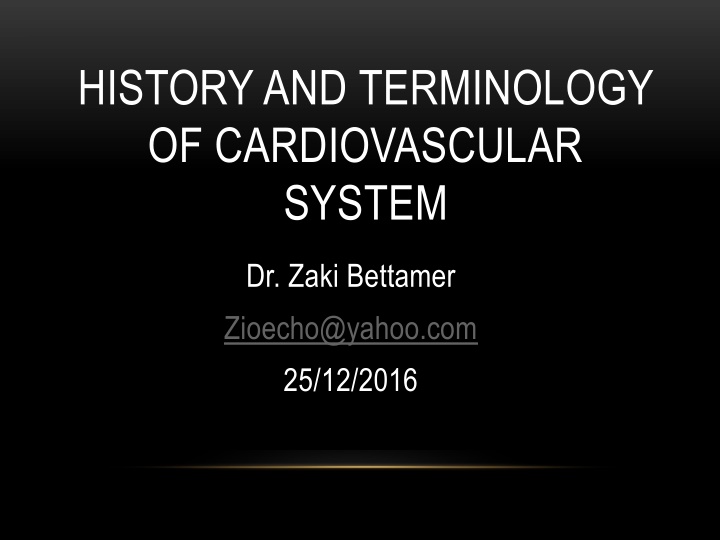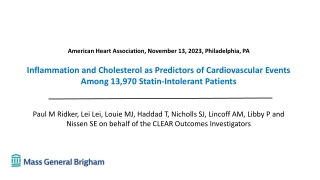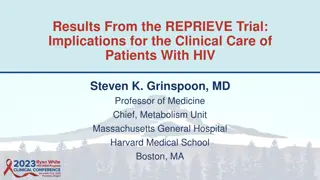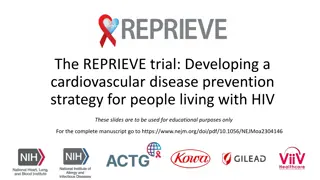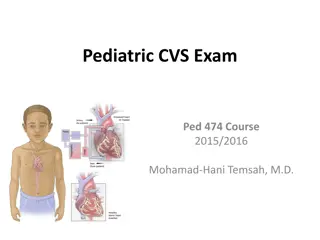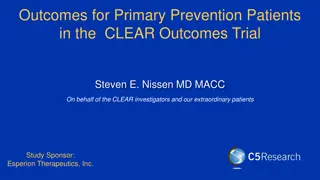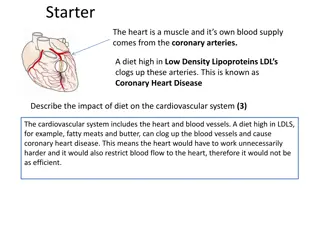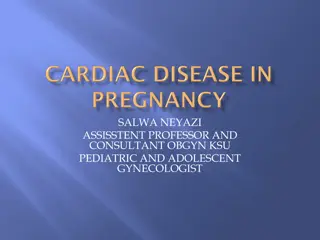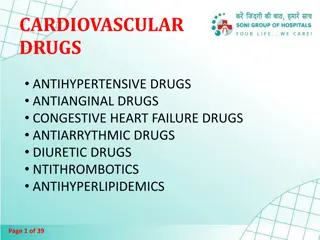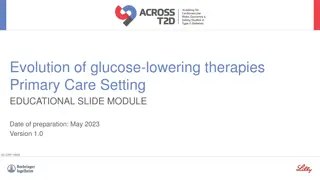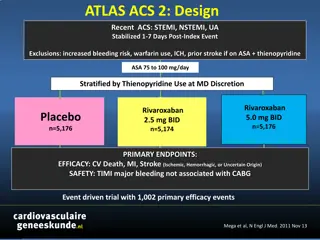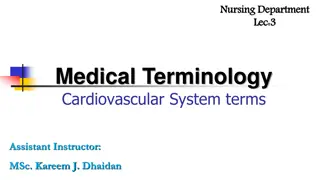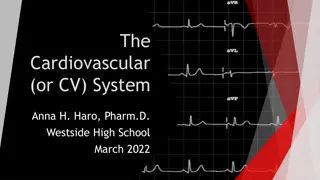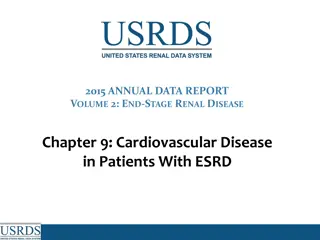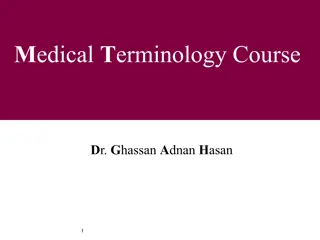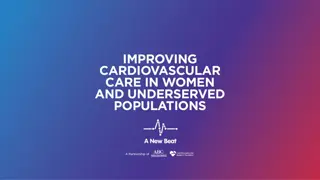HISTORY AND TERMINOLOGY OF CARDIOVASCULAR SYSTEM
Explore the history and terminology of the cardiovascular system, including cardiovascular diseases, disorders of heart rate, rhythm, and conduction, coronary artery disease, vascular disease, diseases of the heart valves, congenital heart disease, diseases of the myocardium, and diseases of the pericardium.
Download Presentation

Please find below an Image/Link to download the presentation.
The content on the website is provided AS IS for your information and personal use only. It may not be sold, licensed, or shared on other websites without obtaining consent from the author.If you encounter any issues during the download, it is possible that the publisher has removed the file from their server.
You are allowed to download the files provided on this website for personal or commercial use, subject to the condition that they are used lawfully. All files are the property of their respective owners.
The content on the website is provided AS IS for your information and personal use only. It may not be sold, licensed, or shared on other websites without obtaining consent from the author.
E N D
Presentation Transcript
HISTORY AND TERMINOLOGY OF CARDIOVASCULAR SYSTEM Dr. Zaki Bettamer Zioecho@yahoo.com 25/12/2016
Cardiovascular disease Disorders of heart rate, rhythm and conduction Diseases of the pericardium Coronary artery disease Diseases of the myocardium Diseases of the heart valves Vascular disease Congenital heart disease
DISORDERS OF HEART RATE, RHYTHM AND CONDUCTION Atrial tachyarrhythmias Supraventricular tachycardias Ventricular tachyarrhythmias Atrioventricular and bundle branch block
CORONARY ARTERY DISEASE Stable angina Acute coronary syndrome STEMI NON STEMI UA
VASCULAR DISEASE Peripheral arterial disease Diseases of the aorta Hypertension
DISEASES OF THE HEART VALVES Rheumatic heart disease Mitral valve disease Aortic valve disease Tricuspid valve disease Pulmonary valve disease Infective endocarditis
CONGENITAL HEART DISEASE Ventricular septal defect Atrial septal defect Patent ductus arteriosus Pulmonary stenosis Coarctation of aorta Aortic stenosis Tetralogy of Fallot Complete transposition of great arteries
DISEASES OF THE MYOCARDIUM Myocarditis Cardiomyopathy Dilated cardiomyopathy Hypertrophic cardiomyopathy Restrictive cardiomyopathy Arrhythmogenic right ventricular Specific diseases of heart muscle Cardiac tumours
DISEASES OF THE PERICARDIUM Acute pericarditis Pericardial effusion Tuberculous pericarditis Chronic constrictive pericarditis
THE APPROACH TO CARDIAC DIAGNOSIS The cardiac history The cardiac physical exam Electrocardiogram Chest X-ray Echocardiography. Lab invx.
RULES 1. Patient should be allowed to tell his history in his own words. 2. Leading questions must be avoided unless the information can t be obtained by other means
QUESTIONS 1. Complete inadequate description. 2. Fill in the gaps in the history not mentioned by patient. 3. Emphasize the important points.
PRESENT HISTORY This means detailed history of the patients present illness which must provide answer for the following questions: 1. Duration 2. Mode of onset (acute, sub acute, chronic). 3. Sequence of events: I. Course (progressive, regressive or recurrent). II. Appearance of new additional symptoms or disappearance of others. III. Treatment received during the course & response. 4. Analysis of each particular symptom.
PAST HISTORY Childhood diseases. Fever or joint pain ,Rheumatic fever Drug therapy. Operations. Prior illness (cardiac, noncardiac). Recent dental work ,IE Prior cardiac procedure
SOCIAL,FAMILY HISTORY Smoking. Physical efforts, Addiction. History of same illness History of sudden death Hereditary diseases
CORONARY ARTERY DISEASE RISK FACTORS Cigarette smoking. Age. Sex. Hypertension. Hyperlipidemia. Family history of CAD. Diabetes mellitus.
SYMPTOMS OF CARDIAC DISORDERS A- Analysis of complaint B- Cardiovascular symptoms : 1-Symptoms of pulmonary venous Congestion. 2-Symptoms of systemic venous Congestion. 3- Symptoms of low Cardiac out put. 4-Chest pain. 5-Cyanosis & jaundice . 6-Palpitation . 7-Symptoms of Peripheral vascular disease . 8-Toxic symptoms
1. PULMONARY VENOUS CONGESTION Causes :- L V F. -M. S. Manifestations : - Dyspnoea - Orthopnoea - P.N. Dyspnoea - Cardiac asthma - Cough - Haemoptysis
SYMPTOMS DUE TO LUNG CONGESTION Dyspnea: sensation of breathlessness and pt reaction to it. pt using accessory muscle of respiration (SCM, Trapezius, scaleni, intercostal muscle) tachypnea: RR >20, normal respiratory rate 15-20 c/min at rest
GRADES OF DYSPNOEA: Grade 1 : no breathlessness Grade 2 : Breathlessness on severe exertion. Grade 3 : Breathlessness on mild exertion. Grade 4 : Breathlessness at rest . (The New York Heart Association )
CARDIAC DYSPNEA Dyspnoea = Breathlessness =uncomfortable awareness of breathing. It is mainly due to reduced elastic properties of the lung (reduced pulmonary compliance). Dyspnea on effort is usually the 1st symptom of pulmonary congestion.
ORTHOPNEA Breathlessness that occurs when the patient lies flat. Dyspnea in a recumbent position. It is usually measured in number of pillows the patient must use to lie in bed (e.g., two-pillow orthopnea). Pathogenesis : 1- Venous return,which in case of LVF, increase pulmonary congestion. 2- Recumbence cause abdominal contents to press up against diaphragm.
PAROXYSMAL NOCTURNAL DYSPNEA ( PND ) Sudden onset of dyspnea occurring while reclining at night, usually related to the presence of congestive heart failure The patient wake up from sleep with severe breathlessness and cough with expectoration ,the attack usually lasts for 5 to 10 minutes by setting or getting up and inhalation of fresh air. Wheezing, due to bronchial endothelial edema is common (Cardiac asthma ) Pulmonary oedema: Dyspnoea become very marked,with prominent central cyanosis ,cough and expectoration of big amount of frothy sputum tinged with blood.
DYSPNEA ON EXERTION Dyspnea provoked by physical effort or exertion. It often is quantified in simple terms, such as the number of stairs or number of blocks that provoke the dyspnea,
COUGH Dry ,or productive of frothy sputum ,occurs on exertion or lying flat , accompanied or preceded by dyspnoea. Haemptysis : -Blood tinged sputum : Pulmonary oedma. -Frank haemoptysis : M. S. Pulmonary embolism and infarction
2. SYMPTOMS DUE TO SYSTEMIC CONGESTION: Pain in the right hypochondrium.congested liver Dyspepsia. Swelling of lower limb,pedal edema or dependent edema,sacral edema Swelling of the abdomen, Ascites Oliguria.
SYMPTOMS DUE TO SYSTEMIC CONGESTION: Causes : R V F. Pericardial diseases. Manifestations : -Oedema of L.L (bilateral pitting ,start in dependent parts,always precedes ascites except in T.V or pericardial diseases (Ascites precox ) -Pain in Rt. Hypochondrium & epigastrium ( hepatic congestion.) -Anorexia & nausea ( G.I. T congestion. )
3. SYMPTOMS DUE TO LOW CARDIAC OUTPUT ( tissue hypoxia brain, muscles, kidneys) Exertional fatigue. Dizziness / Syncope. Oliguria ( <400ml/24hrs) Angina, claudication. Peripheral blue discoloration ,cyanosis, Coldness of extremities blurring of vision
LOW CARDIAC OUTPUT Causes: Stenotic valve lesions :M.S.,A.S. Pulmonary hypertension. Heart failure.
4. CHEST PAIN: 1. Cardiac Origin: IHD, pericarditis, Dissecting aorta, Aortic Aneurysm. 2. Other Causes: Chest wall & Pulmonary: Pulmonary embolism . Pleurisy. Neurological ( cervical, HZ ) Abdominal. ( esophagus, stomach, gall bladder, pancreas). Cardiac neurosis
Analysis: 1. Site & radiation. 2. onset 3. aggrevation & reliefing factors. 4. Duration. 5. progression 6. Character chest tightness,crushing 7. Associated features. SOB, nausea, vomitting, with respiratory cycle (pleurisy) 8. severity
Where ? Site & Radiation What ? Character, Increase , Decrease , Associated symptoms. When ? Onset ,Duration .
5. SYMPTOMS DUE TO CHANGES IN RATE, RHYTHM. Palpitation ( awareness of heart beats ) time, regular or iiregular, relation to exertion, duration, associated dizziness ,syncope, chest pain.
PALPITATION Causes : -Dysrrhythmias - Hyperdynamic circulation. -Volume overload (AR, MR,VSD ) -Anxiety .
PALPITATION Ask about : -Is it regular or irregular ? -Is it spontaneous.? -Onset , Offset , and duration. -Associated symptoms . Example :Spontaneous regular palpitation with sudden onset and offset PSVT
6. SYMPTOMS DUE TO PRESSURE ON SURROUNDING STRUCTURES esophagus, bronchus ( dilated lt atrium, Aortic aneurysm )
7. TOXIC SYMPTOMS : Fever, sweating, loss of weight ,loss of appetite. Fever in cardiac patients : Rheumatic fever infective endocarditis M.I.,pulm. embolism pericarditis ,collagen diseases Myocarditis ( viral, bacterial )
8. SYMPTOMS SUGGESTIVE OF PERIPHERAL VASCULAR DISEASE Coldness of extremities Claudication. Ulcers of the leg .
CYANOSIS & JAUNDICE Bluish ting of skin and m.m. ,due to presence of excessive amount of reduced Hb ( 5g/dl ) in the underlying blood vessel. jaundice Yellowish discoloration of sclera secondary to Liver congestion
CYANOSIS Cardiac causes Central - Congenital cyanotic H.D. -C H F. Peripheral - Low COP. -Peripheral vascular D. -C H F. Ask about: -Onset, is it since birth ? -Is it permanent .? -Site -Associated symptoms.
SUMMARY OF CVS SYMPTOMS lower limb,pedal edema or dependent,sacral edema Ascites Exertional fatigue. Dizziness / Syncope. Oliguria ( <400ml/24hrs) Angina, claudication. cyanosis, Coldness of extremities blurring of vision Pressure symptoms Toxic symptoms Chest pain Palpitation Dyspnoea Orthopnoea P.N. Dyspnoea Cough Haemoptysis right hypochondrium Pain. Dyspepsia.
ANALYSIS Site & radiation. progression Character severity onset aggrevation reliefing factors. Duration Associated features For any symptom
